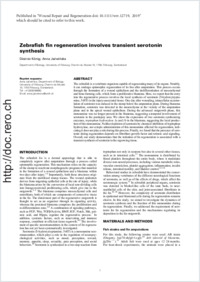Zebrafish fin regeneration involves transient serotonin synthesis
- König, Désirée Department of Biology, University of Fribourg, Switzerland
- Jaźwińska, Anna Department of Biology, University of Fribourg, Switzerland
-
24.04.2019
Published in:
- Wound Repair and Regeneration. - 2019, p. wrr.12719
English
The zebrafish is a vertebrate organism capable of regenerating many of its organs. Notably, it can undergo epimorphic regeneration of its fins after amputation. This process occurs through the formation of a wound epithelium and the dedifferentiation of mesenchymal and bone‐forming cells, which form a proliferative blastema. Here, we report that the entry into the regenerative process involves the local synthesis of serotonin (5‐hydroxytryptamine, 5‐HT) in the injury‐associated tissue. One day after wounding, intracellular accumulation of serotonin was induced in the stump below the amputation plane. During blastema formation, serotonin was detected in the mesenchyme at the vicinity of the amputation plane and in the apical wound epithelium. During the advanced outgrowth phase, this monoamine was no longer present in the blastema, suggesting a temporal involvement of serotonin in the postinjury area. We show the expression of two serotonin synthesizing enzymes, tryptophan hydroxylase 1a and 1b in the blastema, suggesting the local production of this monoamine. Neither depletion of serotonin by chemical inhibition of tryptophan hydroxylase, nor ectopic administration of this monoamine affected fin regeneration, indicating it does not play a role during this process. Finally, we found that the presence of serotonin during regeneration depends on fibroblast growth factor and retinoic acid signaling. Overall, our study demonstrates that the initiation of fin regeneration is associated with a transient synthesis of serotonin in the regrowing tissue.
- Faculty
- Faculté des sciences et de médecine
- Department
- Département de Biologie
- Language
-
- English
- Classification
- Biological sciences
- License
- License undefined
- Identifiers
-
- RERO DOC 326943
- DOI 10.1111/wrr.12719
- Persistent URL
- https://folia.unifr.ch/unifr/documents/307968
Statistics
Document views: 49
File downloads:
- jaz_zfr.pdf: 183
